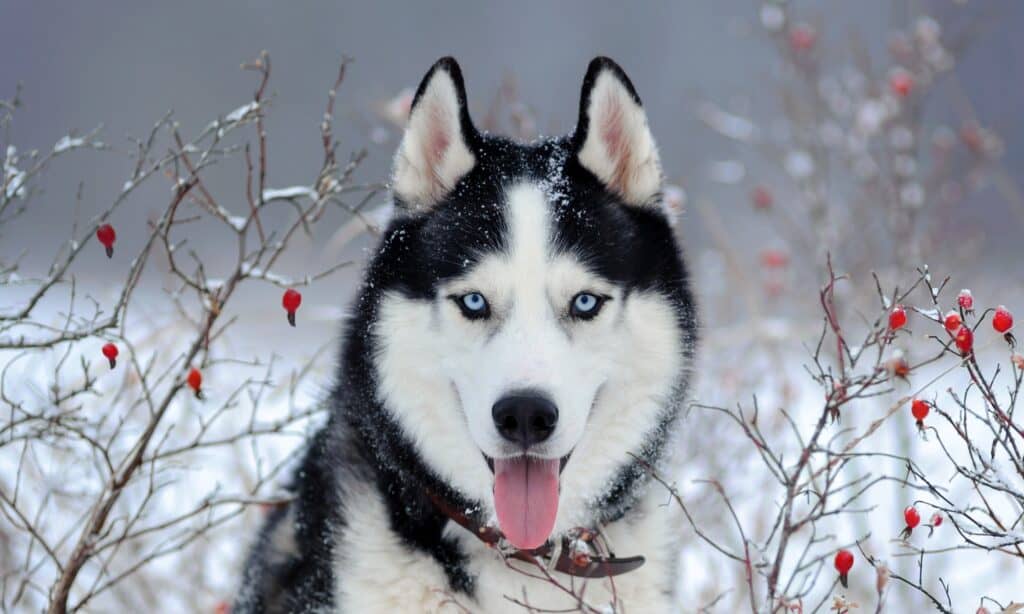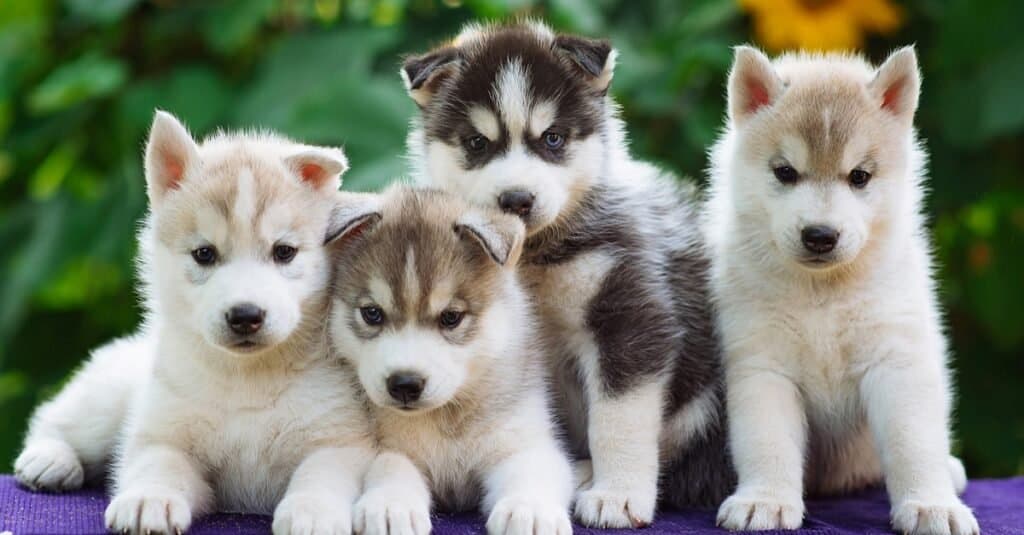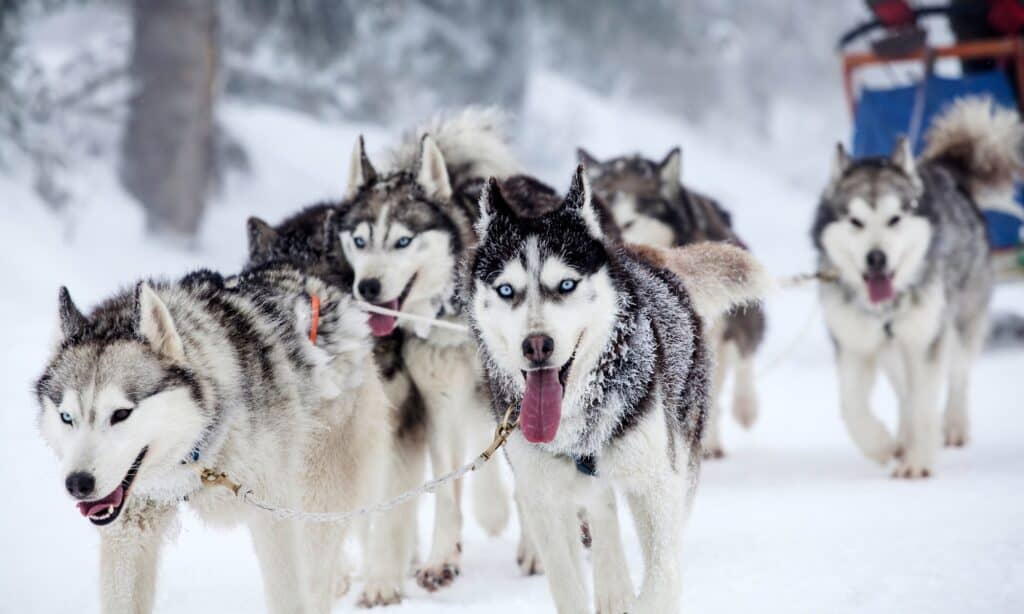Siberian huskies are energetic, intelligent dogs that make great family pets. They are one of the top dog breeds in the United States and fit well with active families. Their markings, thick coat, and strikingly blue-appearing eyes make them a highly distinguishable breed. The Siberian husky is known for being difficult to train due to their independence. Still, with consistency and positive reinforcement, your husky can easily grow into the perfect dog for you and your family. Read on to explore our Siberian husky training guide, recommended cues, timelines, and more.
Is it easy to train a Siberian husky?

The Siberian husky can maintain high energy and run for several hours due to its phenomenal metabolism.
©iStock.com/format35
Huskies are playing and friendly, making them ideal as family pets and companion dogs. They are energetic and loving and bond easily with their owners and strangers. Because of their independent streak, huskies tend to make training more challenging.
Siberian huskies originated in northeast Asia to retrieve and deliver cargo as sled dogs. Because of their origin, huskies thrive in cold, snowy climates and have incredible endurance. They excelled in packs and were eager to please their leader to complete their job. While the desire to please is a positive aspect of training, their independence, and other temperamental traits add more layers to their training. Don’t let this scare you from the breed, though. With consistency, gentle confidence, and positive reinforcement, you will have a well-trained, loving husky living in your home.
What is the best method of training a husky?

Siberian huskies are more suitable as family pets and companion dogs as opposed to guard dogs for security.
©mary.foto.great/Shutterstock.com
Like when training most dog breeds, positive reinforcement is the best Siberian husky training method. Huskies want to bond with their people, so treats, praise, and constant affection are key to training your husky properly. Always reward good behavior, and try not to punish bad behavior excessively.
Consistency is also important in your Siberian husky training. Training should occur multiple times a day — prioritize quick, effective sessions instead of longer periods once per day. Always have treats readily available, and start early. Younger husky pups have a short attention span but are also mischievous.
Siberian Husky Training Timeline

Contrary to popular belief, Siberian huskies are not part wolves. While they share some characteristics, their personality is opposite of the wolf.
©Rabinger Photography/iStock via Getty Images
8 to 16 Weeks
Socialization
During the first few weeks of bringing your Siberian husky puppy home, begin to prioritize socialization training. Teaching cues and commands are important, but try to expose your husky puppy to as much as possible early. Take them to new locations, allow them to play with other dogs, and encourage people to pet and play with them. Touch their feet, their mouth, their belly, and help them understand this is normal behavior that will happen throughout their life.
Crate Training
It’s no secret that Siberian huskies have a reputation as skilled escape artists. Start crate training immediately. Not only does this give you a secure place to leave them, but it’s also a safe space for them to relax.
Potty Training
Immediately start establishing a potty routine. Take your puppy outside constantly, and reinforce where it is appropriate to do their business. Potty training takes time and patience, but avoid setting your puppy up for failure. To start, always take your puppy outside in the morning, before bedtime, after naps, after playtime, and when they leave the crate.
Obedience Training
Start working on basic commands such as sit, stay, and leave it. Remember to remain positive and patient, and reward good behavior every single time.
Loose Leash Walking
Always remember that huskies want to pull. They entered this world as sled dogs, and it is in their genetic make-up to pull on a harness or leash. It is crucial to introduce them to their leash immediately and start helping them feel comfortable. Leash training can be challenging, so be patient and give it time!
4 to 12 Months
At this point in your puppy’s life, continue to build on the foundation you created when they first came home. Expand on obedience training and start adding more cues and commands to practice.
Diligently focus on loose leash training for your pup as well. Reward your husky when it checks in during walks and walks at your pace. Don’t be afraid to let them stop to sniff because this encourages a gentle walk. Remember, gentle walks go against their instincts, so loose leash training is vital for a well-behaved leashed husky.
As your husky ages, it will only develop more independence. Be aware of their common escape tactics — don’t be surprised if they figure out how to open doors and unlock their crate. Put safety measures in place and observe your husky’s behavior. They can be tricksters!
Common Siberian Husky Training Mistakes

Siberian huskies can pull heavy sleds through deep snow. This makes them ideal for delivering cargo and rescue missions.
©iStock.com/8213erika
Repeating Commands
Repeating commands is a common dog training mistake in general. It is very tempting to repeat your command continuously until your dog obeys. Unfortunately, this teaches your dog to ignore you and the command. Instead, say the command once and wait. Even if you wait for one to two minutes, be patient and wait out your puppy. They will eventually give in, and their response will become quicker.
Not Providing Enough Stimulation
Huskies were born to run. They are highly energetic dogs with a lot of stamina. Always provide your husky with an outlet to safely run long distances to burn off steam. Otherwise, they will become bored, anxious, and sometimes destructive.
This is also true for mental stimulation. While training is a great mental focus for your husky, consider adding some mental enrichment puzzles and exercises into your pup’s routine.
Not Recall Training
Siberian huskies are curious dogs, and they will easily bolt if not contained or trained. Consider adding recall to your initial training and use that as part of your foundation. When using the come command, your pup will learn to return to you when called. As your relationship deepens with your husky, their desire to please will only grow stronger as well.
The photo featured at the top of this post is © iStock.com/Andrii Zorii
Ready to discover the top 10 cutest dog breeds in the entire world?
How about the fastest dogs, the largest dogs and those that are -- quite frankly -- just the kindest dogs on the planet? Each day, AZ Animals sends out lists just like this to our thousands of email subscribers. And the best part? It's FREE. Join today by entering your email below.
Thank you for reading! Have some feedback for us? Contact the AZ Animals editorial team.






